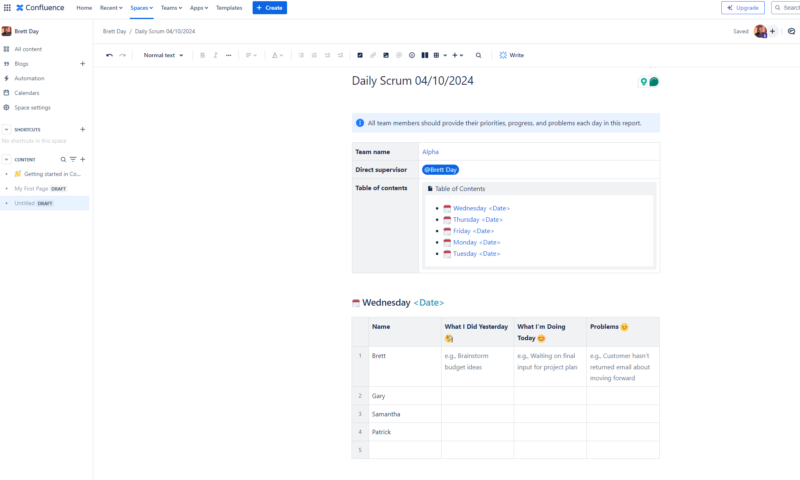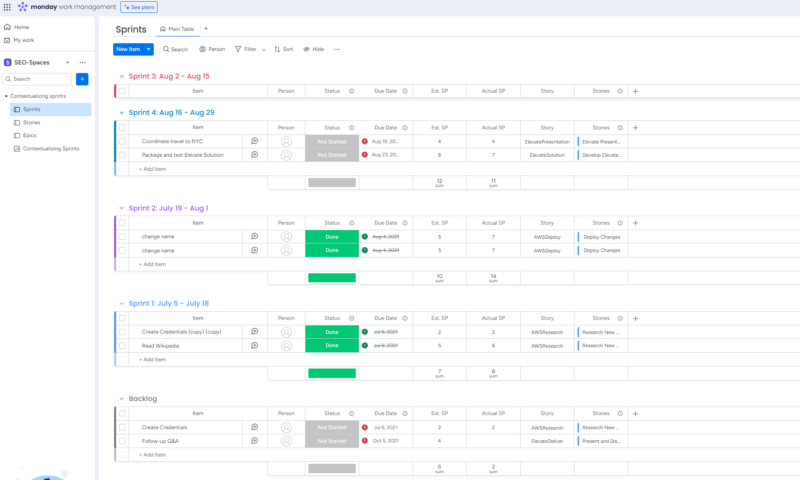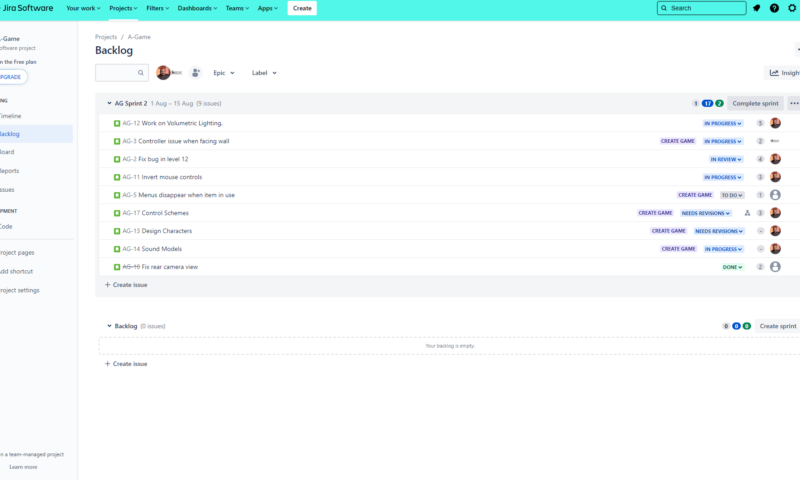If you’re new to Scrum and are confused about daily scrum meetings, don’t worry; we’re here to help. Daily scrum meetings, which can be planned with the best project management software, are a vital part of the Scrum framework. The meetings help teams better understand what’s happening during the current sprint and can increase team collaboration.
Below, we’ll explain what a daily scrum meeting is, who attends it, what’s covered during the meeting and how it differs from stand-up meetings. For good measure, we’ll also provide you with hints and tips on how to run a daily scrum meeting successfully. Let’s jump in.
What Is a Daily Scrum Meeting?
A daily scrum, which is typically held in the same place (in person or remote) and at the same time, is a 15-minute meeting (scrum event) that occurs during each day of a sprint. It is also called a daily stand-up meeting. It is held so the development team members, the scrum master and the product owner can discuss the project’s progress.

templates within Jira to plan daily scrum meetings.
Who Starts the Daily Scrum: The Role of the Scrum Master
Daily scrums are the scrum master’s responsibility. The scrum master’s main job is to unite scrum teams and oversee the overall project. However, while the scrum master ensures the daily scrum occurs, the development team leads the meeting itself.
Daily scrums are meant for internal team members to discuss the team’s progress, but external stakeholders and clients can occasionally be present. When this happens, the scrum master must ensure visitors do not interrupt, as the 15-minute meeting cannot be extended.
What Is the Main Reason for the Scrum Master to Be at the Daily Scrum?
The scrum master is the leader of in-person, remote or distributed teams; as such, they must be present during the daily scrum to ensure that everyone who needs to attend is present and that development team members know how to conduct the meeting.
Who Is Required to Attend the Daily Scrum: The Role of Scrum Team Members
Every team member playing an active role in the current sprint must attend the daily scrum. In general, this means that the scrum master, the product owner and the development team members must be present for the 15-minute time-boxed event. Stakeholders and clients who are considered to be other team members in Agile are not required to attend.
What Is the Purpose of the Daily Scrum?
The primary purpose of the daily scrum is for teams to inspect progress and discuss how they can adapt or make changes so the team can work more efficiently toward the sprint goal. Additionally, the daily scrum is used to quickly discuss roadblocks and impediments, improve communication and collaboration, and develop the team’s overall knowledge of the project.
The Three Daily Scrum Questions
With daily scrum meetings lasting just 15 minutes, there’s no time to play around. Each development team member must answer three questions within the time constraints. The developers’ answers will let the scrum team know how they’re progressing. Below, we will look at the three questions asked during the meeting.
1. What Did You Do Yesterday?
The first question that must be answered addresses what developers did the previous day. Each developer must state what they worked on and the progress they made on a user story or feature. Once everyone has answered this question, project leaders can gauge the progress made during the sprint.
2. What Will You Do Today?
The second question asks what developers will do that day. Developers must state which user story or feature from the sprint backlog they will tackle that day. Once every developer has answered this question, the development team, product owner and scrum master will better understand where the project is heading.
3. Can You Identify Impediments in Your Way?
The last question that needs to be answered allows the developers to list any problems or impediments that might stop them from completing their tasks. This question is perhaps the most crucial of the three because the project may fall behind schedule if issues cannot be resolved.
Daily Scrum Guide: How to Run a Meeting Successfully
Holding a daily scrum meeting is one thing, but consistently having successful daily scrums is another. Below, we’ll share some tips that will help ensure that each 15-minute daily scrum is as productive and enlightening as possible.
Daily Meeting Tips
- Be consistent: For successful daily scrums, you should hold the meeting in the same place (or with the same software for remote teams) and at the same time each day. This will help the entire team know what to expect.
- Stick to the timeline: Scrum masters must ensure that each team member knows that stand-up meetings cannot be longer than 15 minutes.
- Only answer the questions: Ensure that each member participating in the daily scrum only answers the three questions mentioned above. The daily scrum is not a place to discuss personal matters or other project information.
- Handle impediments separately: If a team member states that they have a problem, note it and deal with it separately after the daily scrum meeting.
Project Management Software Tools for Daily Scrum
The development team, the scrum master and the product owner can use various tools to show project progress during the daily huddle. The tools include:
- Kanban and scrum boards: A task board can quickly show assigned tasks and which user stories and features have been completed.
- Product backlogs: The backlog, which the product owner controls, can give a good idea of the tasks and features to work on during the current sprint.
- Team velocity reports: If time permits, the scrum master or product owner can use a report generated by one of the best Agile tools to show the team’s velocity.
- Issue and bug trackers: Issue and bug trackers in software platforms can be used to note impediments and problems that developers report. We suggest using monday.com for teams using the scrum framework. You can learn more about the software in our monday.com review.

supports many Agile processes, including sprints.
What to Avoid in a Status Meeting
Project leaders must ensure that daily scrums cover the essentials and nothing else. If you’re not careful, a daily scrum meeting could become a drama-filled event. When this happens, you’ll have problems. Below is a list of issues and topics to avoid.
- Attendance drops: If you notice that team members stop participating in daily scrums, it could be a sign that they feel it’s a waste of their time. As soon as this happens, reevaluate your meetings, reset the meeting tone and ensure they stay on point going forward.
- Personal stories: Under no circumstances should the time for a daily scrum be used to share personal stories. Ensure all participants understand they should only share information that answers the three daily scrum questions.
- Problem-solving: Daily scrums are not for problem-solving. Product owners should make note of any issues and deal with them later.
- Backlog refinement: Backlog refinement should not take place during the daily scrum. This scrum event should be reserved for sprint review meetings.
- Bickering: The 15 minutes for daily scrums should not be used for bickering, finger-pointing or other such activities. If this happens, your team may be suffering from other Scrum anti-patterns. Team member issues should be handled privately, and problems with processes should be discussed during a sprint retrospective meeting.
- Long meetings: Daily scrum meetings should be 15 minutes long, period. There’s simply no need for them to last any longer.

Daily Scrum vs Stand-Up Meeting
Though you might think that daily scrum and stand-up meetings are the same, they are different. We’ll cover the key differences below.
| Criteria | Daily Scrum | Stand-Up Meeting |
|---|---|---|
| Meeting Length | Meetings last 15 minutes | Meetings can be shorter or longer than 15 minutes. |
| Meeting Frequency | Scrums are held daily during a sprint. | Stand-up meetings are not held daily. They can be weekly, bi-weekly, monthly or at other intervals. |
| Meeting Agenda | Daily scrums are for discussing completed work, upcoming work and impediments. | Stand-up meetings can be used to discuss any issues the team is experiencing. |
| Location & Time | Daily scrums are held at the same time and place each day. | Stand-up meetings can be scheduled at different times and held in various locations. |
| Meeting Format | The daily scrum format never changes | The format for stand-up meetings can be changed to suit the meeting. |
| Meeting Participants | Team members actively work during the current sprint, but generally, only the scrum master, developers and product owner participate in the daily scrum. | Project leaders, developers, stakeholders and clients attend stand-up meetings. |
How to Run a Daily Scrum Meeting
To ensure that your daily scrum meeting goes off without a hitch, you should follow the steps below.
- Ensure all team members know when and where the daily scrum meetings will occur.
- Make sure that every team member knows what can and cannot be covered during the 15-minute time box event.
- If any outside influencers (stakeholders or clients) attend the daily scrum, ensure they know not to interrupt the software development team.
- For a daily scrum meeting to be successful, all attendees must participate. Project leaders should encourage participation and champion open communication.
- Do not use the daily scrum for quick decision-making. Leaders should solve issues after the daily scrum.
Is a Stand-Up Meeting Different From a Standing Meeting?
A stand-up meeting is a gathering where individual team members take turns discussing what they’re working on and bring up any issues they may have. A standing meeting is a meeting that takes place at regular intervals.
Final Thoughts
Daily scrum meetings are an essential component of the Scrum framework. These meetings allow developers to discuss what they have worked on and what they will work on next, and alert project leaders to any issues they’re having. They are also the ideal way for scrum masters and product owners to keep tabs on project progress and touch base with everyone.
While daily scrums are associated with Scrum, daily Agile stand-up meetings can be used during any Agile project. If you want to incorporate a daily event, follow this guide. Did you find our guide helpful? Do you feel ready to hold daily scrums? Do you hold daily meetings in your project management methodology of choice? Let us know in the comments. Thanks for reading.
FAQ: Daily Scrum Meetings
-
Two intended outcomes of a daily scrum are understanding what individuals worked on the day before and what they will be working on during the current day.
-
During the daily scrum, developers should discuss what they worked on the day before, what they plan to work on that day and any issues or impediments they’re facing.
-
Daily stand-ups always cover the same three topics: what you did the day before, what you will do that day and which impediments stand in the way.
-
Daily scrum meetings are held at the same time and place to create consistency within the team. When teams know when and where they are expected to be, they will be there consistently.
The post What Is a Daily Scrum Meeting: Guide & Definition for 2024 appeared first on Cloudwards.

